Humane Education Lessons for Building Character
In addition to instruction in reading, writing, arithmetic, and other academic subjects, teachers are expected to provide students with lessons on becoming a good person. Why? Because, for a variety of reasons, not every child receives these lessons at home, and if teachers didn’t show them right from wrong, those students would struggle in their interactions with their peers throughout their school years—and beyond. This is why nearly every state has enacted legislation or a policy that provides educators with guidelines on instilling compassion, empathy, respect for others, kindness, and other desirable character traits—all of which can be taught through humane education—in their students.
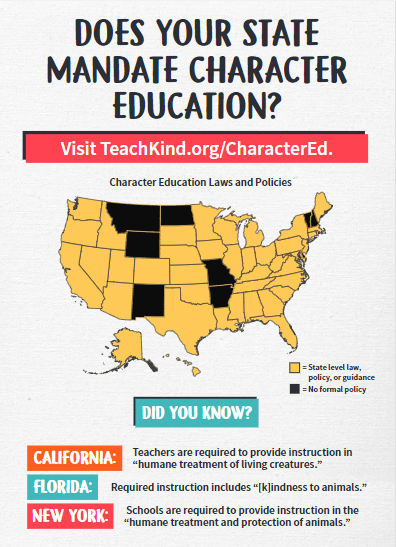
By teaching young people to treat all sentient living beings as the individuals they are—regardless of their species—we can cultivate a positive classroom culture, celebrate diversity, and foster prosocial growth in our students, while also reducing bullying and violence in our schools and communities.
Good citizens’ admirable qualities are often presented to students in isolation when they’re still learning how to embody them. For example, it’s not uncommon to read stories about the importance of being honest or helpful, or your school may promote one character trait in particular each month, like kindness or responsibility, and reward students who are “caught” displaying it. The following lessons and activities focus on an issue pertaining to animals and advocate a specific character trait.
By appealing to children’s innate capacity for compassion toward animals, we can motivate them not only to learn but also to apply what they learn in authentic ways. When we encourage empathy toward animals, children demonstrate more empathetic behavior toward their peers. Use these resources to teach students of all ages some of the most common traits highlighted in character education laws throughout the country and to inspire them to express these traits when interacting both with their classmates and with animals.

Cooperation
The following lessons and activities teach students the importance of working effectively with others in order to accomplish a common goal.
Elementary
TeachKind Rescue Stories: Freddie on the Run (3–5)
TeachKind Rescue Stories: Jake’s Recovery (3–5)
Middle and High
“Change for Chained Dogs” Fundraising Pack
TeachKind Rescue Stories: Songwriter and Student Save Lamb From Slaughter (9–12)

Responsibility
The following lessons and activities teach students the importance of being conscientious and accountable for their actions. Many of these resources focus on responsible companion animal care.
Elementary
TeachKind Rescue Stories: Florence the Cat Survives a Flood (K–2)
Inspiring Rescue Videos to Teach Compassion for Fish
“It’s Raining Cats and Dogs!” Activities
“Share the World” Curriculum Kit (K–2 and 3–5)
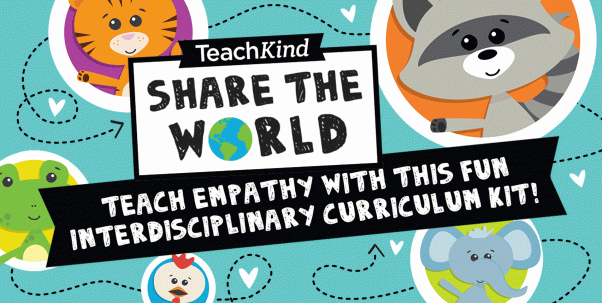
Middle and High
TeachKind Rescue Stories: Lucky and the Good Samaritan Who Saved Her (6–8)
Inspire Empathy for All Living Beings With a Gallery Walk (9–12)
Debate Kit: Should All Companion Animals Be Spayed and Neutered? (9–12)
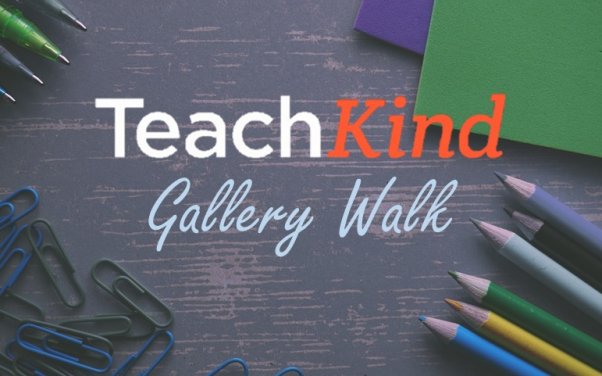
Citizenship
The following lessons and activities teach students the importance of doing their civic duty and being a productive member of the community.
All Grades
Fishing: Activities to Teach About the Human Impact on the Environment
“Save Dogs at Texas A&M University” Activities
Elementary
“Community Helpers Can Be Heroes for Animals, Too!” Activity (PK–1)
“Share the World” Curriculum Kit (K–2 and 3–5)
Middle and High
TeachKind Rescue Stories: Miss Willie’s Bucket List (6–8)
Kindness
The following lessons and activities teach students the importance of being friendly, generous, and considerate and treating others the way they wish to be treated.
Elementary
“What Winter Is Like When You’re a ‘Backyard Dog’” Activities (K–2 and 3–5)
“What Would Gandhi Do?” Activity
“Set Kind Classroom Goals” New Year Activities
“Seeds of Kindness” Spring Activities
Kind Student Award (Printable)
“Share the World” Curriculum Kit (K–2 and 3–5)
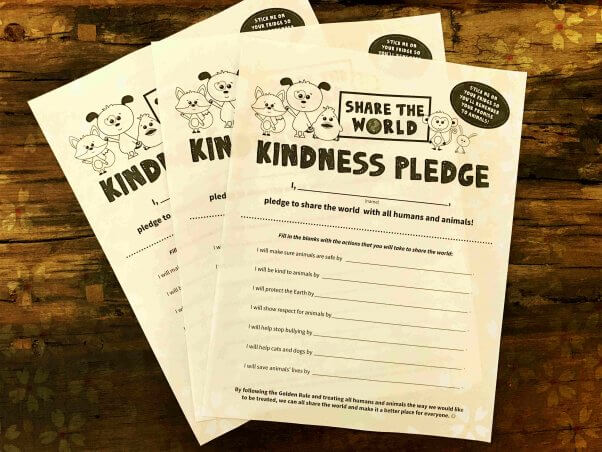
Middle and High
“What Winter Is Like When You’re a ‘Backyard Dog’” Activities
Respect
The following lessons and activities teach students the importance of acknowledging and honoring the rights and autonomy of others and treating others the way they wish to be treated.
Elementary
“How to Heal a Broken Wing” and Other Lessons in Empathy (K–2)
“Kids Who Are Heroes to Animals” Inspirational Reading Comprehension Passages (3–5)
“Share the World” Curriculum Kit (K–2 and 3–5)
Middle and High
TeachKind Rescue Stories: Camels Waheed and Tracy Fall in Love (6–8)
TeachKind Rescue Stories: Songwriter and Student Save Lamb From Slaughter (9–12)
Honesty
The following lessons and activities teach students the importance of telling the truth and of being trustworthy and self-reflective.
Middle and High
“Cognitive Dissonance and How We Treat Animals” Activities
Self-Control
The following lessons and activities teach students the importance of exercising restraint, self-discipline, and willpower.
Elementary
“‘Hey, Little Ant’: Little Guy Makes a Big Case” Activities
“Hobbes Goes Home” Emotions Dice Game
Tolerance
The following lessons and activities teach students the importance of accepting others’ differences, celebrating diversity, and being open-minded.
Elementary
“Esther’s Story: Don’t Judge a Book by Its Cover” Activities
TeachKind Rescue Stories: Esther the Wonder Pig (3–5)
“Not-So-Scary Animals” Activity Sheets
“How to Heal a Broken Wing” and Other Lessons in Empathy (K–2)
Sea Life, Not Seafood: Lessons on “A Fish’s Life”
Truly Awesome Turkeys: A Thanksgiving Lesson
TeachKind Rescue Stories: Rescued Rats Find New Home (3–5)
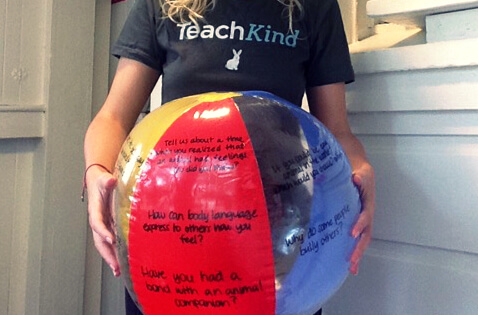
Middle and High
Conflict Resolution Activity Sheet
Environmental Stewardship
The following lessons and activities teach students the importance of protecting and preserving the Earth’s natural resources, keeping the natural world clean and pristine, and doing their part to reduce their impact on the environment and their contribution to the climate crisis.
All Grades
Animal-Friendly Earth Day Activities
“How Littering Hurts Animals” Activities
Elementary
“Amazing Arctic Animals” Printable Mini Book and Activity
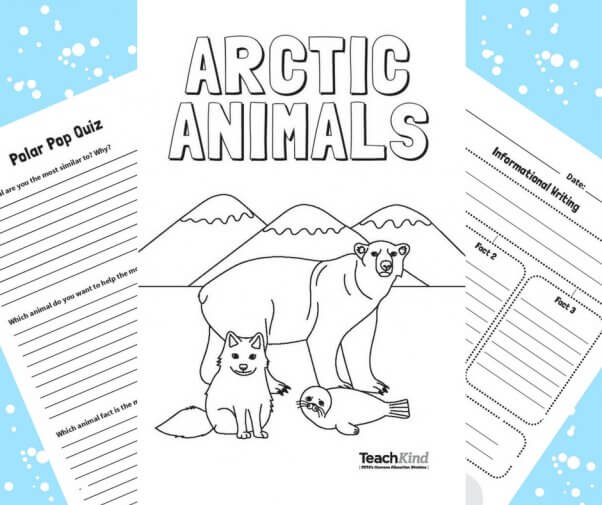
Middle and High
Debate Kit: Is Animal Agriculture Harmful to the Environment? (9–12)
Social Justice
The following lessons and activities teach students the importance of recognizing privileges and advantages that they may have and others don’t and working to ensure that all members of society—regardless of race, gender, species, or any other factors—are treated fairly and with respect.
All Grades
“Women in Leadership and Animal Rights” Activities
Black History Month Activities
Martin Luther King Jr. Day Activities
Elementary
“Orcas Belong in the Ocean” Lesson Plan (K–2)
“Tilikum: Casualty of Confinement” Lesson Plan (3–5)
Betta Fish Belong in the Wild: Empathy-Building Literacy Centers (3–5)
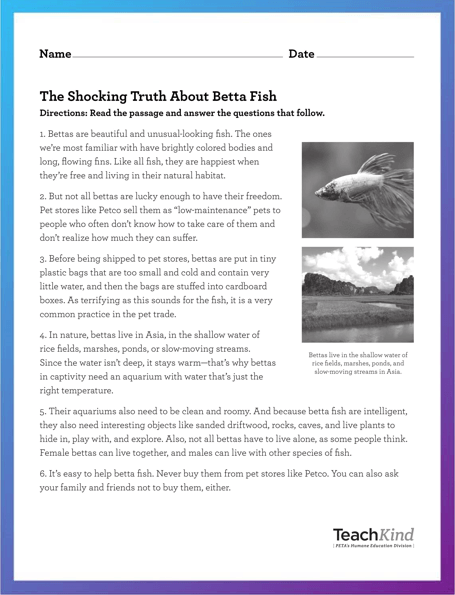
Middle and High
“SeaWorld Kills: Imprisoning Animals in Amusement Parks” Lesson Plan (6–8)
“What’s a Vegan?” Human Supremacy Writing Activity (9–12)
“The Devil’s Dictionary: Euphemisms” Activity (9–12)
Debate Kit: Should the Commercial Seal Slaughter Be Stopped? (9–12)
Debate Kit: Is It Ethical to Eat Animals? (9–12)
Debate Kit: Should All Companion Animals Be Spayed and Neutered? (9–12)
Debate Kit: Is Animal Agriculture Harmful to the Environment? (9–12)
Debate Kit: Should Animals Be Used in Experiments? (9–12)
Debate Kit: Should Marine Mammals Be Held in Amusement Parks? (9–12)
*****
Many state character education laws—including those of California, Florida, and New York—specifically indicate that students should learn to be kind to and protect animals—yet these important values are often overlooked in favor of focusing on material that appears on state-administered tests. But what good is an education if students lack the fundamental soft skills that they need in order to treat others with civility, kindness, and respect?
This certainly isn’t an exhaustive list. All TeachKind materials can be used to teach compassion, kindness, respect, and empathy, and with a little creativity, you can teach any positive character trait through humane education. Not sure how to get started? Check out TeachKind’s free webinar Key Element of a Humane Lesson, and feel free to contact us with any questions that you may have.
Stay up to date on all the latest animal-friendly content from us by signing up for TeachKind News:
By submitting this form, you’re acknowledging that you have read and agree to our privacy policy and agree to receive e-mails from us.





